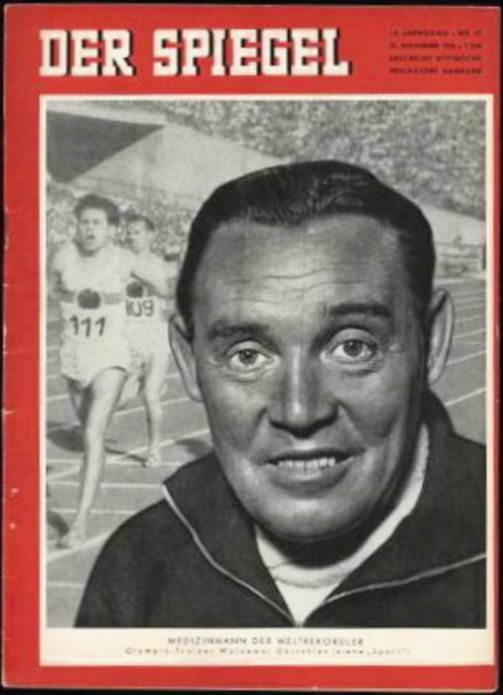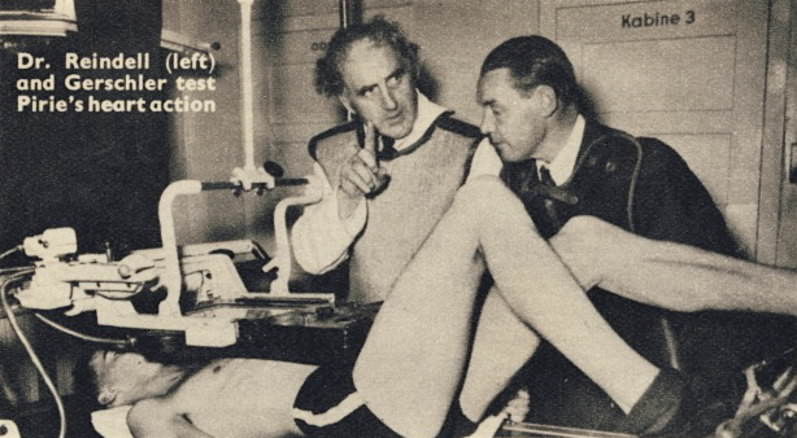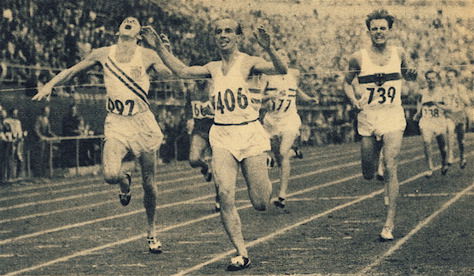COACH PROFILE: WOLDEMAR GERSCHLER
1904-1982
 |
| Gerschler's success was honoured by Der Spiegel. |
Although the Second World War and its aftermath interrupted his coaching career just as it had begun to flourish, Woldemar Gerschler established himself as one of the world’s leading running coaches in the 1950s. Above all, Gerschler was an innovator; using physiology to a greater degree than previous coaches, he developed a very specific training regime that became known as interval training. Frank Horwill, one of England’s top coaches from the 1960s, wrote that Gerschler was “30 years ahead of him time.” (Horwill, Athletics Weekly, 1982) Gordon Pirie described Gerschler in a similar way: “His approach to training distance runners was well ahead of its time.” (Pirie, Running Fast and Injury Free, p.10. www.ebooksee.com) As well as being an innovator, Gerschler successfully trained world-class athletes like Harbig, Barthel, Pirie, Hermans, Moens and Barris.
Gerschler attended university in Leipzig for teacher training, but when he graduated, Dresdner SC, a leading sports club, offered him the post of Chief Coach. From the start he was a hard taskmaster, and he used science to develop his methods.
In 1935 he met Rudolf Harbig, a 21-year-old 800 runner who had run the modest time of 2:04. Gerschler’s methods evolved through his coaching of Harbig, whose improvements were regular and dramatic. After competing as a member of Germany’s 4x400 relay team at the Berlin Olympics, Harbig reached world class in 1938 when he won the European 800 in 1:50.6 min. The next year he set a German 800 record with 1:49.4 and then in a race with Lanzi on a 500m track, he ran 1:46.6, a shocking 1.8 seconds under Wooderson’s world record. This time would stand for 16 years. On another 500 track in Frankfurt, he then ran a 400 world record in 46.0. Harbig continued to run during the first part of World War 2 and in 1941 set a 1,000 world record with 2:21.5. Harbig’s performances strongly confirmed the efficacy of Gerschler’s training innovations.
It is not clear whether Gerschler continued wartime coaching after 1941. It is known that after the war ended, he worked as a soccer coach until 1950, when he got a job at the Institute of Physical Education at the University of Freiburg. He worked there as head of the Institute until 1971.
In a World Sports article in 1958, Gerschler pays tribute to four men for his success: his University teacher Hermann Altrock (“By his enthusiasm and wisdom, he made me a disciple of sport.”); Soccer coach Jimmy Hogan (“He made me into a soccer coach…and taught me much about sport coaching generally.”); Josef Waitzer (He…gave me my first real understanding of athletics.”); and Hans Reindell. Dr. Reindell, a cardiologist who provided the medical knowledge for Gerschler’s program for many years. (WS, Feb., 1958, 44.)
Despite the success of his athletes, there was a lot of criticism of Gerschler’s method; many saw it as “too tough and dangerous.” But Reindell was always on hand to support Gerschler’s ideas: “Time after time, our methods, based on Professor Reindell’s research, have been proved justified,” Gerschler wrote. (WS, Feb., 1958, p. 45.)
 |
| This famous picture in World Sports caused concern in some quarters. |
Gerschler’s method, which did evolve and change over the years, was most clearly described in a 1963 Track Technique article (#12, 1963) written by Gerschler himself. The article justifies interval training (IT) against LSD (long steady distance), which through Arthur Lydiard was gaining popularity among runners. Gerschler admits that LSD also develops the heart, but he gives three good reasons why he prefers IT: 1. It takes less time; 2. It imposes a more powerful stimulus; 3. It permits a more exact control on the intensity of the stimulus and on the duration of the effort. In the Track Technique article, Gerschler admitted that the most difficult aspect of his system to sell was that efforts over only 100m and 200m were necessary.
Gerschler’s method has four criteria: 1. The length of the effort; 2. The chosen speed; 3. The duration of recovery; 4. The number of repetitions.
The main purpose of IT is to develop a bigger, stronger heart: “A close relationship exists between the capacity for work and the dimension of the heart.” (TT, #12, 1963) And it is the recovery, not the effort, that develops the heart, or, in the words of Gerschler, that “enables a stimulus particularly powerful to reach the heart.” (TT, #12, 1963) The recovery can be done by the runner lying on his back or jogging. But the heart-rate must get down to 120-140 before another repetition is started.
 |
| Jose Barthel, one of Gerschler's successful runners, winning the 1952 Olympic 1,500. |
In another Track Technique article a year later (#17, 1964), Gerschler focused more on muscles. He argued that IT gave more stimulus to muscles than LSD. To explain this he introduced the concept of Local Muscle Endurance (LMR): “the ability of the cells to adjust to a state of oxygen debt.” Thus there needs to be a balance between general endurance and LMR. Middle-distance runners would need more LMR; for distance runners the balance would be even. LMR is achieved through near maximum efforts done in quick succession. These efforts are done over 100 and 200. However, in this later article Gerschler says he added 400 repetitions but found that the results were not as good those from 200 repetitions “because the oxygen debt is partly paid off during the 400 run.” (TT, #17, 1964)
Despite his scientifically proven system, few runners followed his basic tenets of not repeating an effort until the pulse is down to 120-140 and of using only 100 and 200 efforts. Getting an accurate pulse reading was well nigh impossible for most people in the fifties and sixties. Also, as Gerschler had found, most runners could not accept that 100 and 200 repetitions were sufficient. (Gordon Pirie, one of Gerschler’s athletes later claimed that he used longer repetitions when training under Gerschler.) A perusal of Fred Wilt’s How The Train shows the infinite variety of IT that was practiced by the leading runners of the late 1950s. Most runners used IT to develop their legs to run comfortably at racing speed. IT for most was speedwork, although there was a recognition, vague though it was, that IT also strengthened the heart. Still, As Frank Horwill has pointed out, every time we see a runner doing repetitions we should remember Woldemar Gerschler. 
| Gerschler’s Sessions: The purpose of each effort was to get the pulse up to about 180 beats per minute. After the effort, 90 seconds of recovery was allowed to get the pulse back down to 120-125 beats per minute. Then the next effort was undertaken. If the recovery took longer than 90 seconds, the effort had been too fast. If it took less than 90 seconds to recover , the next effort was begun as soon as the pulse hit 120. The number of repetitions depended on the ability to continue to bring the pulse down to 120 within 90 seconds. |
More details on Woldemar Gerschler can be found in the following:
Gerschler, W. “The Man Behind the Champions.” World Sports, Sept., 1954, pp. 28-31.
Gerschler, W. “Too Tough? No, No!” World Sports, February, 1958, pp. 44-45.
Gerschler, W. “Interval Training.” Track Technique, September, 1963, pp. 391-6.
Gerschler, W. “Training for Middle and Long Distance Running.” Track Technique, Sept. 1964, pp. 530-2.
Horwill, Frank. “Gerschler: The Innovator. Athletics Weekly, Sept.18, 1882, p.33.
Sprecher, P. “Visit with Dr. Woldemar Gerschler. Track Technique, Sept. 1962, pp. 282-4.
3 Comments